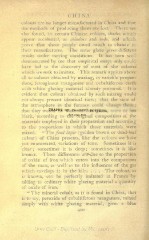Page 488 - Oriental Series Japan and China, Brinkly
P. 488
CHINA
colours are no longer manufactured in China and that
the methods of producing them are lost. There are
also found, in certain Chinese colours, shades which
appear accidental, as celadons and reds, and which
prove that those people owed much to chance in
their manufacturcvS. The same glaze gives different
results under varying conditions. It has been well
demonstrated hy me that empirical essays only could
have led to the discovery of most of the colours
which we seek to imitate. This remark applies above
all to colours obtained by mixing, in variable propor-
tions, ferruginous manganese and cobaltiferous earth
with white glazing material already prepared. It is
evident that colours obtained by such mixing could
not always present identical tints that the state of
;
the atmosphere in the fur :n
;
that they wo$Mp q&W-ffsiNG POTTERY.
black, ^according to p composition of the
tffe ^r?^nal
materials employed in their preparation and according
to the proportions in which those materials were
mixed. "The / .as (golden brown or dead-leaf
colour) of China presents, like the colours we have
just enumerated, variations of tone. Sometimes it is
clear sometimes it is deep ; sometimes it is like
;
bronze. These differences areSdue to the proportion
of oxide of iron which enters into the components
of the mass, as well as to the influences of the gas
which envelops it in the kiln. . . . The colour, as
is known, can be perfectly imitated' in France by
adding to ordinary white glazing material a quantity
of oxide of iron.
" The mineral cobalt, as it is found in China, that
is to say, peroxide of cobaltiferous manganese, mixed
simply with white glazing material, gives a blue
400

